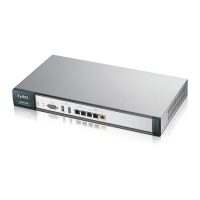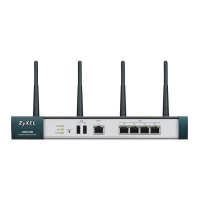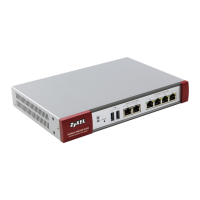Chapter 31 Bandwidth Management
UAG Series User’s Guide
374
The following table describes the labels in this screen.
Table 166 Configuration > BWM > Add/Edit
LABEL DESCRIPTION
Create new
Object
Use to configure any new settings objects that you need to use in this screen.
Enable Select this check box to turn on this policy.
Description Enter a description of this policy. You can use alphanumeric and ()+/:=?!*#@$_%-
characters, and it can be up to 60 characters long.
BWM Type Select Shared when the policy is set for all matched traffic.
Select Per user when the policy is set for an individual user.
Select Per-Source-IP when the policy is set for an individual source IP.
User Select a type of the user account to which to apply the policy. Use Create new Object if
you need to configure a new user account. Select any to apply the policy for every user.
Schedule Select a schedule that defines when the policy applies or select Create new Object to
configure a new one (see Chapter 41 on page 453 for details). Otherwise, select none to
make the policy always effective.
Incoming
Interface
Select the source interface of the traffic to which this policy applies.
Outgoing
Interface
Select the destination interface of the traffic to which this policy applies.
Source Select a source address or address group for whom this policy applies. Use Create new
Object if you need to configure a new one. Select any if the policy is effective for every
source.
If you set BWM Type to Per-Source-IP, you can only select a source address (group)
that contains no more than 256 IP addresses.
Destination Select a destination address or address group for whom this policy applies. Use Create
new Object if you need to configure a new one. Select any if the policy is effective for
every destination.
DSCP Code Select a DSCP code point value of incoming or outgoing packets to which this policy applies
or select User Define to specify another DSCP code point. The lower the number the
higher the priority with the exception of 0 which is usually given only best-effort
treatment.
any means all DSCP value or no DSCP marker.
default means traffic with a DSCP value of 0. This is usually best effort traffic.
The “af” choices stand for Assured Forwarding. The number following the “af” identifies
one of four classes and one of three drop preferences. See Section 12.4 on page 212 for
more details.
User-Defined
DSCP Code
Use this field to specify a custom DSCP code point.
Service Type Select Service Object or Application Object if you want a specific service (defined in a
service object) or application patrol service to which the policy applies.
Service Object This field is available if you selected Service Object as the service type.
Select a service or service group to identify the type of traffic to which this policy applies.
any means all services.
Application
Object
This field is available if you selected Application Object as the service type.
Select an application patrol service to identify the specific traffic to which this policy
applies.
DSCP Marking Set how the UAG handles the DSCP value of the incoming and outgoing packets that match
this policy.

